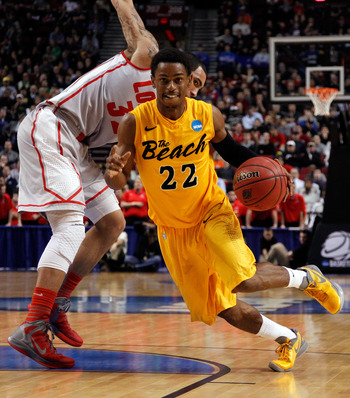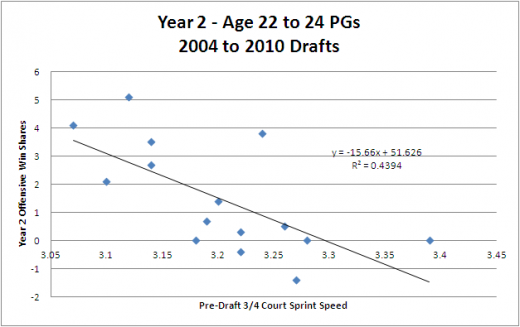Kevin’s Summer Project, Part 2: Point Guard Speed
2012-11-15(I will preface this article by saying that while I was on the calendar for today, Nate Smith and Tom Pestak also posted excellent articles on Kyrie’s defense and Andy’s untradeableness. Bear down for a long sit of Cavs: the Blog reading and check out the articles below. It is worth it.)
Last week, hopefully you read the intro to “Kevin’s Summer Project”, when I laid out the groundrules of a study correlating pre-draft measurements with NBA offensive performance. The first article primarily asserted that most of the measurements do not prove highly useful, with some exceptions. Today, the first of those exceptions will be explored; the implications of speed for point guards.

Who is this guy? Perhaps he could have been the Cavs' back-up PG. Apparently he was too small or something.
For primary ball-handlers, of the pre-draft measurements, three-quarter-court sprint speed served as the truest barometer of future offensive success. The other athleticism tests, primarily leaping, also featured frequent positive correlations, but size proved unimportant. Actually, nearly 90% of the size-to-offense correlations were negative. Small, fast floor generals ruled, starting at the top with sub-six-foot Chris Paul and including players as short as 5’ – 8” Nate Robinson.
The following table reflects the accumulation of speed correlations with offensive win shares.
Fairly strong, including nothing lower than 0.10, one of the two ‘all player’ correlations above 0.50, and two robust values of 0.63 and 0.66; definitely a promising trait corresponding with NBA offensive production. But what else can this info tell us?
First, note the sub-trend of speed factoring as a larger predictor of success for upperclassmen. I will credit this to the overall importance of skill and production over athleticism or size. While many highly regarded underclassmen flex strong athleticism, a more critical component to being draftable at a young age is dominance on a basketball court; athleticism alone does not provide for elite basketball. Many underclassmen posted marginal measurements, but were very skilled, and progressed to highly successful NBA players. The list includes Chris Paul, Michael Redd, Kevin Durant, LaMarcus Aldridge, Al Horford, and Al Jefferson. These are highly skilled players that began exhibiting their abilities at a very young age, whereas many upperclassmen were not draftable at an earlier age, because they could not develop their talents to this high of a caliber. Hence, a higher tendency for reliance on size and athleticism.
Now back to point guards and how the idea relates to pre-draft valuation. While speed registers as a valuable commodity at draft time, the impact on draft positioning does not seem prevalent enough for upperclassmen. The correlation between draft position and sprint time for upperclassmen point guards is 0.22, a number far exceeded by each of the applicable values in the table above. The list of drafted upperclassmen point guards from 2000 through 2010 with sprint speeds below 3.20 is: Speedy Claxton, George Hill, Darren Collison, Kirk Hinrich, Derrick Zimmerman, Ty Lawson, Jameer Nelson, Chris Duhon, Will Blalock, Eric Maynor and Earl Watson. This looks fairly unremarkable until the average draft position of 28 is viewed, with only one player selected before 18th. Despite the inauspicious draft positioning, nine of the eleven players outperformed their selection status. The two non-contributors came off the board at 40th and 60th, so even with higher draft-day weighting towards speed, these players are probably second round picks. Each of the other players warranted earlier selection than actual. Finally, one addition expanded this list in 2011; 60th pick and eventual all-rookie team member Isaiah Thomas. Apparently the trend towards small, fast point guards was not realized sufficiently to fix that one.
So; small, speedy, upperclassmen point guards are undervalued by NBA teams. A sub-trend is that the new hand-checking rules initiated in 2004 – 2005 increased this group’s success. While three of the five underclassmen correlations showed mild upticks, upperclassmen correlations rose dramatically, including all values above 0.50. The graph below reflects the most-correlated data, with Ty Lawson, Jameer Nelson and George Hill populating the upper-left section and several less successful candidates filling up the low-lying portions. The primary outlier at 3.9 offensive win shares is Jarrett Jack.
Drilling down further to determine combinations of traits that even more reliably provide NBA success, elite upperclassmen performers in both speed and agility rise to the top. While not as strong for agility as for speed, correlations were always positive with occasionally high results. From 2000 to 2010, the list of drafted, upperclassmen point guards who finished their sprint in less than 3.2 seconds and their agility drill in less than 11 seconds is: Speedy Claxton, Kirk Hinrich, Chris Duhon, Jameer Nelson, Earl Watson, Darren Collison, Ty Lawson, and Eric Maynor. As the only player to meet these thresholds in 2011, Isaiah Thomas provided a stellar rookie season. Every one of these players exceededed the expectations associated with their draft position, which should lead NBA teams to draft similar players higher. No dice though; no upperclassmen selected in 2012 met these levels, even though Casper Ware was otherwise draftable and surpassed these marks. Now playing in Europe, through six games in Italian LegaDue, his 22.6 PER helps pace his team to 4 wins and 2 losses. Draftexpress.com lists his ‘best case’ as Isaiah Thomas, and I had Ware ranked 46th in the class of 2012. Too bad the Cavs don’t desperately need a shot-creating second string point guard. They do? Apparently they needed Luke Harangody more.
For underclassmen point guards, the highest correlations were actually with leaping, with speed sitting in second place. In a somewhat interesting twist, upperclassmen posited negative correlations for the leaping drills. This will be explored deeper during the look at defense, but the agility drill may be more conducive to skills associated with role-players, a position more likely to be the dominion of older draftees. The combination of strong speed and jumping from underclassmen produces a very exciting list of prospects. Young point guards faster than 3.15 with a no-step vert of 30″ or greater is: Derrick Rose, Russ Westbrook, Mike Conley Jr, John Wall, Nate Robinson, and Jerryd Bayless, with no additions in 2011 or 2012. Obviously, this package is highly sought-after, featuring five lottery-picks, four top-fives, and two number-one overall selections. There is no additional draft-day-value to be extracted from young, talented, explosive point guards; possibly my most shocking discovery from this series. (one side note; the recent run of Rose, Westbrook, and Wall sort-of served as Kyrie Irving’s primary weakness leading up to the draft. Pundits generally thought that Kyrie’s lack of athleticism removed him from ‘star’ potential. In hindsight, clearly there is still a place at the top of the point guard heap for non-freak athletes who are young, highly skilled and ridiculously productive. Kyrie, Chris Paul, and Deron Williams…your jobs are safe.)
Ok. So I have potentially proved too expansive for one article and missed many important points, while hitting (or missing) on lesser elements. Let’s wrap this up. To summarize, as it relates to offense for point guards, there are four main takeaways supported by numbers:
- Athleticism is helpful, with speed as most prevalent, and agility (upperclassmen) and leaping (underclassmen) also relatively important.
- The success rate of fast, agile upperclassmen point guards is very much underappreciated on draft day.
- Since 2004, the importance of speed in a floor general has marginally increased.
- Size doesn’t matter
Come back next time, for a deeper look at shooting guard offensive production.



Kevin,
Would you being willing to post or allow access to your data? I know you list your sources and it’d be possible to recreate, but quite a pain.
Thanks.
Exactly. In fact, I find that teams who try to post up the short point guards end up taking their teams out of their offensive flow entirely. I’d certainly love to see Casper over what we have going on now. Do you think the Laker’s pick could get us Jimmer Fredette right now? He can’t buy minutes, but at 10 minutes a game, he’s got a 26 PER. How is he not playing more? Not that I want two point guards who can’t play defense… The other thing ticking me off? Minnesota finally figured out how to get something out… Read more »
Kevin, I think more research may be required for defense vs. offense… How does speed, agility, height, etc. translate to DWS vs. OWS, and defensive efficiency rating? I think the big knock on lil’ guys is that they can’t defend (though Ware seemed to have a decent defensive reputation). Also, i think the other knock on Ware was very pedestrian shooting numbers, which were probably depressed for the same reason Isaiah Thomas’s were in college: too much focus of the defense was on him. Thomas’s numbers improved in the pros, and he had more help in Washington than Ware did… Read more »
Nate Smith, I agree the defensive correlations will point to size being important, but not more important that speed was to offense. That discussion will come later. As it relates to picking a guy like Ware at #50 (or any small, fast PG), or signing him as an undrafted FA, all a team is hoping for is a bench dynamo for 15 minutes a game. He could very well have the skills to be that. The defensive shortcomings in that scenario are somewhat overcome through him guarding the other team’s back-up. How many teams are going to run their offense… Read more »
The thing about Caspar Ware that was so awesome in college was watching him play. He was that good. He was also very good in street leagues. I think many coaches have no idea who to play sometimes.
I think this is a good post, but what the Cavs really need right now are better defenders and small, quick point guards can have a very tough time with defense. See: Ramon Sessions. Still, anything to help this bench now would be welcome.
Are shorter PG’s just as good as taller ones even after adjusting for speed and agility? For instance, it seems intuitive that if I have a choice between a 6’4″ PG and a 6’1″ PG who are equally athletic, I pick the 6’4″ one. Is that true, or is there really no correlation at all?
Nathan, There are relatively few “fast” PG’s that are also tall. Certainly Wall, Rose, Westbrook qualify, but they are of a different breed, and that is part of the reason they were all top five picks. George Hill is tall, Kirk Hinrich is tall, but I don’t know that either of them has been worlds more successful than Jameer Nelson or Ty Lawson. Typically, small, fast PGs have seen more offensive success (90% of size correlations were negative). Perhaps my eventual post on defense will shine additonal light on this, but if two point guards are otherwise equal athletically, but… Read more »
Nice article. Speed helps if you have a team that can use it. I don’t know that the Cavs get over the hump with one fast PG and Walton, Casspi, Miles, Harangody, etc shooting in the .200s. It looks like a drive and kickout is no more effect when these guys are laying bricks. That aside and in support of your piece, I find it hard to believe Grant thought something different than what we already knew about Sloan and Gibson. With KI and Andy (hopefully Dion) tearing it up the games are probably going to be close so most… Read more »